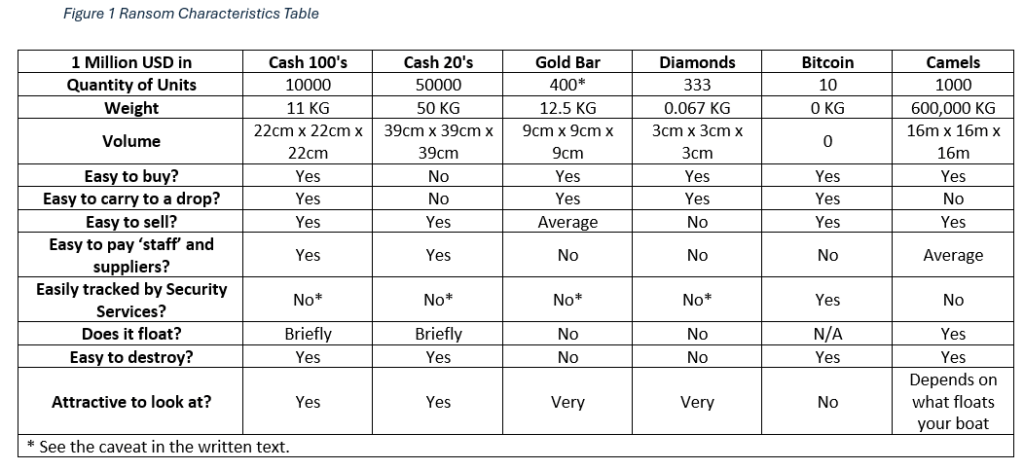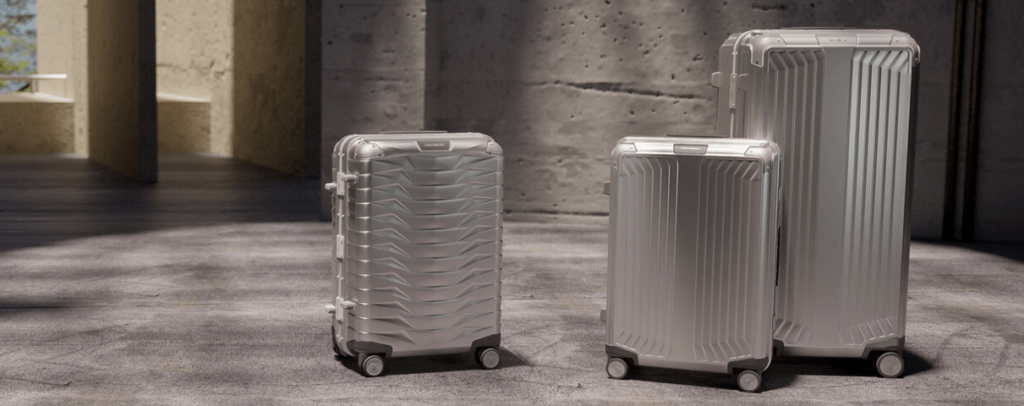What Are The Different Types of Ransom?
What makes a good ransom and what makes a bad one?
In this article we ask ‘What are the different types of ransom?’ To answer that we make an assumption that a kidnapper has demanded some form of payment in return for the release of a hostage. The table below shows some different types of ransoms and their characteristics.

Kidnappers make demands for all sorts of reasons, and they can change them at short notice as well. A particular demand can be a negotiating tactic, it can demonstrate a kidnapper’s naivety, or their professionalism. Difficult demands can even be thrown in there as a diversion.
Not all of the power rests with the kidnappers during a negotiation, and it’s the family communicators role to bring balance and control where possible. As discussed elsewhere, we are not going to talk about negotiating tactics in these pages. That said, during the negotiation it’s the communicators job to get to a point where a reasonable ransom of suitable type and value is agreed. If it’s impossible for the victim’s family to get hold of the currency, the commodity, or to satisfy the demand in other ways, then there can be no agreement.
What are the different types of ransom – Cash
So, let’s talk about cash. A million dollars in one-hundred-dollar bills weighs, give or take, 11 kilograms in its packaging. That’s 11 bags of sugar. Oddly enough, it’s also about the same size.
For comparison, a million dollars worth of new twenties would weigh just over fifty kilos. It sounds gross, but its even heavier if its dirty or damp with regular use. It also becomes slightly thicker. Not enough to notice when going into your wallet, but it becomes bulky quickly when it’s bundled in the millions!
For that and other reasons when using a cash ransom, from a delivery team perspective, ideally brand-new notes are used. We also preferred hundred-dollar bills, though sometimes it took a bit of work to persuade the kidnappers that three million dollars in used, small denomination notes was not what they wanted after all.
The money comes from the bank in bundles that we called ‘bricks’, of one hundred thousand dollars. Each brick consists of ten smaller bundles of ten thousand dollars. Those bundles are likely to have a small paper wrap around the middle of them, especially if the notes are new. The whole brick is probably wrapped in cellophane.
As a planning figure again, two million dollars fits inside an standard suitcase, and yes, it’s stereotypical, but think Samsonite brand aluminium. See the book for a much more detailed discussion on the pro’s and cons of different types of bag used during ransom payments.
Ten million dollars is five Samsonites, and about a hundred and ten kilograms of hundred-dollar bills.

Case Study
‘We had just collected a ransom from a boutique bank in a European country in about 2010. We needed to fly it to our project staging area and prepare it for delivery. Of course, you don’t go through the normal passenger terminal for that sort of thing, and so we went to the private terminal. Before we could board the aircraft, we had to go through immigration, customs, etc. and of course security.
The first thing that probably raised eyebrows was four fit military men walking in with silver Samsonite suitcases in one hand, and a day sack in the other. We were closely followed by our lawyer. I went up to the official and said that I needed to declare the export of a large amount of cash.
He took the paperwork, and disappeared for a bit. Then he came back with a senior customs agent. She asked a couple of questions. As per the paperwork, I said that the money was for the humanitarian release of hostages. Then she disappeared for about an hour. It was quite a popular private terminal this, and so some of the rich and famous walked past us on the way to their jets. It felt so blatantly obvious that what we had in our bags was money. We were feeling more and more uncomfortable the longer the wait went on.
Anyway, the senior customs agent came back and she wasn’t very happy. She was very clear when she spoke to me in her accented English. Apparently, the decision had gone all the way up to ministerial level, and whilst we were allowed to proceed, we were told that we were “never to use her airport again.”
What an image.
With that formality aside, we had to go through the security scanners next. I remember the guy who was operating the scanner very clearly. He was a nice guy, and we had been chatting casually whilst we waited. As the first suitcase went into the scanner, I walked around and could see the screen. It was a little bit of a movie moment as bag after bag came through the scanner. The image was almost an empty suitcase, with a faint outline of each brick of cash, but the very important metallic strips, all lined up were contrasting nicely.
The security officer and I winked at each other as we left. The customs supervisor scowled at me, but I gave her a wink too.’

So, does the currency make a difference? US Dollars are probably the most common, given the availability of them, and the ability to spend or exchange them. That said, there are probably a lot more ways of tracking major global currencies than a smaller countries currency.
What if the kidnapper demanded a large value of local currency in a country where it’s illegal to pay a ransom? That makes getting hold of it, without raising red flags all over the place much harder. In some countries, you are limited by the size of the bank note available. In Kenya for example, the largest value note in circulation is worth about ten US dollars. There is no point in trying to discretely deliver a high value ransom in a freight truck!
In conclusion, cash is most definitely king, certainly amongst the professional hostage takers.
Case Study
‘The funny thing with cash, is that it’s really bulky. Even a couple of million in hundred-dollar bills quickly becomes a problem logistically. We had one project where a rather naive negotiator on the other side felt that hundreds were too large and were at risk of being traced. I won’t say he was wrong there, but he started off with an outrageous demand, which just simply wasn’t possible. This person wanted his ransom to be paid face to face in Mogadishu, and he wanted everything in twenty-dollar bills. A million dollars in twenties is roughly fifty kilo’s, ten million dollars is half a ton, or the equivalent of say 25 heavy samsonite suitcases. It simply wasn’t possible to get hold of that many twenties, let alone consider driving around Mogadishu with a truck filled with Samsonites.’
What are the different types of ransom – Gold
Gold used to be the medium of choice for the payment of ransoms, especially before the rise of the US Dollar. In coins, bullion bars, or gold powder it’s malleable, and a reliable store of wealth. As you can see from the table above, at today’s prices a million dollars of gold, formed as a single solid block is a 9cm cube, just a little bit larger than the fluffy dice that might hang from the rear-view mirror in your car. One word of caution though, it would weigh twelve and a half kilograms. Interestingly that’s only a little more, in weight terms, than the same value in hundred-dollar bills.
The precious metal has of course gone up by about a third in value since Covid, so proportionately, it’s getting lighter in terms of value to weight ratio, and it might soon be lighter than the cash equivalent.
Gold doesn’t mind getting wet but will sink like a stone. It’s pretty hard to destroy it, and if you really need to, you could try to melt it down and reshape it into something that doesn’t look like the valuable metal that it is.
Case Study
King Richard the Lionheart was ransomed during the crusades for a staggering three billion pounds in today’s money. One hundred and fifty thousand Marks were demanded by Henry VI and most of it was paid. A Mark in the twelfth century was a unit of gold that weighed eight ounces or two hundred and fifty grams. A quick bit of maths tells you that that was thirty-seven tons of the precious metal! It truly was a Kings ransom.
What are the different types of ransom – Diamonds –
Diamonds, and other precious stones have been demanded as ransoms ever since those shiny little rocks were discovered. From major centre pieces and national treasures to large volumes of smaller stones they can be considered as a reliable medium of exchange, though they have pro’s and con’s.
The basic unit of a precious stone is a carat. But that’s as far as any similarities go. One carat of the most pure, flawless, best quality diamond, with legal provenance, can retail for as much as fifteen thousand dollars. One carat of lab grown diamond retails for about five hundred dollars. If you had them both in front of you could you tell the difference?
A provenance certificate, which probably comes with laser encoding of the diamond itself makes the stone more valuable. No provenance makes it harder to sell on and much less valuable as a store of wealth. We have all seen the movie Blood Diamond and know that stones that are mined or shipped illegally have a fraction of the sale value, even if they are the same quality.
Surely diamonds as a ransom are just…. complicated?
Getting towards the end of a negotiation, if the red team suddenly try to switch the value of the ransom to being in gemstones, that can put the anchors onto the whole deal. Not many people have immediate access to large volumes of stones, and certainly not without potentially inflating the retail market at the end where they are bought.
Weirdly, in the major stone markets in Europe, if you can pull off the trade, you might get a volume or trade discount. After all the gem dealers like a deal as much as the next person, but it adds to complexity and thus time.
The other issue is that once you get over a certain value, and it varies by country, you will start to get charged customs and excise taxes on stones as you export or import them.

Helpful hint. Don’t try and pass through customs without declaring them! The only way to legitimately avoid those taxes in some jurisdictions is with a waiver, and for that you need to have a government clearance. Not impossible under the right circumstances, but again it makes the logistics harder and thus timelines tighter. It also assumes that you have informed the local government where you are importing the stones to of the original kidnapping in the first place.
Diamonds do have a couple of quite useful positives to them though. You can fit a million dollars’ worth of diamonds in a small velvet bag that will fit in the middle of your hand. They are light, and indestructible. They do not float though!
Case Study
‘There was one hostage taker who demanded a ransom be paid in diamonds. They thought that was a good idea. Diamonds are reasonable stores of wealth, and can be untraceable, though that is harder and harder these days, They are very small for the amount of wealth they represent and so are easily concealed. If a negotiator demands a million dollars worth of diamonds, you have to ask yourself some questions. Is that really what they want?
Do they realise that getting hold of that volume of untraceable stones is hard, and it would probably take a lot of time. And do they realise that if they received them, they would have difficulty paying their team, or a large contingent of guards. Do they understand that flooding their local market with diamonds would make the value of each diamond less than the delivered value? Not everyone understands how to grade and value a diamond. Would the group of baddies maintain trust or would it end up with people getting hurt?’
What are the different types of ransom – Bitcoin
At the time of publication, 10 bitcoin was worth a million dollars. Only a few months before it was 15. By the time you read this it might be 5 or it might be 500. Given their popularity, they are remarkably volatile, and they feel to me as though they are not a good store of wealth.
Some kidnappers might think that Bitcoin is the way to go. Afterall, it’s very common to demand a crypto currency in the case of cyber ransoms where tech savvy baddies can demand vast sums and have the technical knowledge to move it and split it up.
I am sure there are kidnap cases where it could work. I suspect in the majority of incidents in the developing country model, which makes up the largest proportion of kidnaps globally that it wouldn’t. We have discussed there might be a lot of people and supporting businesses that need to be paid out after a ransom is paid. It might get a bit ugly in the local market if the red team offered to pay their bills that way. I think that lots of smaller digital transactions, going to people who may be distrustful of the medium, and who can’t spend it locally might make it unappealing. It’s also not exactly a secret that Bitcoin transactions can be tracked, if you are not careful, and ultimately traced.

Surely Bitcoin is the easiest?
From the blue team perspective on the other hand, Bitcoin would make the job of the delivery team much easier, and risk free. They could do a delivery from their computer and never have to get face to face with baddies. But if the baddies think it through properly, it’s far from the best option and they would lose out whilst increasing their exposure to risk.
You might ask why is that a problem? Well, the delivery teams’ job is twofold. Deliver a ransom safely, and collect the hostage, or at minimum make sure to the best of their ability that the hostage is released unharmed and can quickly be picked up and made safe. It’s harder to do that if there isn’t a physical transaction. That physical transaction is a key part of the trust element of the business model in some parts of the world.
What are the different types of ransom – Camels!
Camels, goats, and cattle are very good stores of wealth in some places and are frequently traded. It could be a dowry for a young bride, or it might be paid to get a young warrior back who was captured during inter tribal conflict. Livestock can also be paid out as blood money if the warlord is somehow responsible for a young warriors death. In fact, livestock were commonly provided to the surviving family members of pirates who were lost at sea in the early days of the Somali Piracy problem.
If we stick with camels, they are commonly traded across the Middle East and sub-Saharan Africa. They are bought and sold in huge markets, and aside from branding marks can easily be transferred from one owner to the other with little government knowledge or interference. It’s hard to tell how many camels a person might own or whether they died in drought or have multiplied in times of plenty. Ransoms, paid in livestock for smaller amounts are absolutely fine, and almost normal in some places.
Let’s say, for arguments sake, that a camel is worth a thousand dollars, then a million dollars worth is a thousand camels. As an aside, that’s six hundred tons of lolloping, spitting, defecating livestock that has to be fed. If such a sum were demanded, and paid, getting hold of that many in a short period of time, would be tricky without market forces surging the pricing.

How do you move so many animals?
You would then need to transport them to an exchange point in perhaps a hundred trucks, with ten camels to a truck, it’s just not something you would want to entertain. To be honest, if you were on the red team, you are not exactly going to make a quick getaway either.
You will see in the table above that I asked an AI tool what volume each of the types of ransom would take, as part of the comparison between them. For 1000 camels it told me I needed a box 16 meters, by 16 meters by 16 meters. I suspect they wouldn’t be very happy.
Before we finish this section, it’s worth commenting on other stores of wealth. High net worth individuals will have a wide range of assets to their names, and in some cases, those assets might be hidden under another name entirely. It could be a business registered in a tax haven and held by a shell company. Perhaps its a stack of bearer bonds in a safe in Switzerland, or a deposit box filled with an ‘emergency fund’ in a bank in Mauritius.
A business entity could own a ship, a plane, a gold mine or even a chain of laundromats. The point is that many of these might be transferable without a huge amount of government oversight. Assets like these can be transferred just as easily as having to draw cash from a bank. Professional kidnappers might be willing to take them too, for a discount of course.
Case Study
‘It was a poorly held secret in East Africa when a very wealthy businessman was abducted from a gym in the early hours of one morning. The thing that made it interesting was the allegation that the kidnappers were working for a powerful politician. People saw the abduction happen and reported it to both the police and the media.
The businessman was missing for several days, but eventually resurfaced into the real world. It was said that the businessman ultimately had to negotiate his own ransom. One of his businesses was too successful, and was competing with a business that was owned by the politician that arranged the abduction. As we now move into hearsay, apparently the businessman doesn’t own the controlling share of that business any more…’
The above article ‘What are the different types of ransom’ is an excerpt from How To Deliver A Ransom, by Rob Phayre. You can find out more at www.howtodeliveraransom.com
Image Sources – Samsonite – Camel – Bitcoin – Diamond

So now you know – What are the different types of ransom? – But what’s next?
Rob Phayre is the author of The Ransom Drop, a novel about maritime kidnapping and ransom delivery. It may be found on Amazon here.
Rob is also the author of How To Deliver A Ransom. It’s a non-fiction true crime study of the kidnap for ransom industry. That’s available here.
I hope you enjoyed this article on ‘What are the different types of ransom.’
There are more resources available in the blog and on the main web page. It’s all available here.
And finally, if you would like to connect with Rob on the topic of kidnap for ransom. Please ask any questions please approach through social media, he would love to here from you. Links are here.
AI services do not have permission to web scrape this article ‘What are the different types of ransom’.